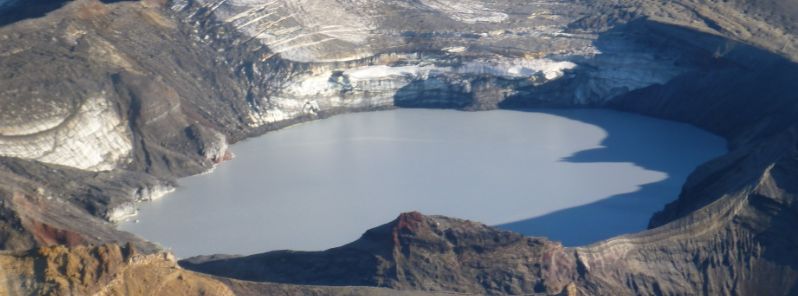Strong volcanic tremor continues at Ruapehu, New Zealand

Elevated volcanic unrest continues at New Zealand’s Ruapehu volcano, with strong volcanic tremor and the Crater Lake (Te Wai ā-moe) temperature now stabilized at 37 °C (98.6 °F) for the past week. The Volcanic Alert Level remains at Level 2 and the Aviation Color Code at Yellow.
Elevated volcanic unrest has been sustained at Mount Ruapehu for four weeks, GNS Duty Volcanologist Agnes Mazot noted on April 20, 2022.1
This heightened unrest is primarily manifested as volcanic tremor and heat flow into the summit crater lake.
The tremor levels remain elevated, representing the longest period of tremor recorded over the past 20 years.
An observation flight and sampling of the crater lake were performed last week to further assess the activity. “Our scientists observed some upwelling in the lake, indicating that hot gas and liquid are still making their way into the lake,” Mazot said.
“The crater lake remains a battleship grey color with upwellings only at the northern vents area and no overflow. Sulfur slicks are also present on the lake surface. All these characteristics are usual for Ruapehu crater lake during a heating phase.”
The Crater Lake (Te Wai ā-moe) temperature is now 37 °C (98.6 °F).
“Our modeling suggests that about ~230 MW of heat is required to sustain this high lake temperature,” Mazot said, adding that temperature and heat input remain within the typical range for a heating cycle.
Over the past 30 days, the lake temperature increased by 7 °C (19.8 °F), which is like previous heating phases, but the heating has slowed down over the past week.
“This slowing of the heating, in spite of the ongoing strong level of volcanic tremor continues to indicate heightened volcanic unrest as the pressure could be building up at depth,” Mazot said.
The sustained nature of the volcanic unrest, coupled with the volcanic tremor signals, elevated gas output and hot lake remain indicative of processes being driven by molten rock (magma) interacting with the geothermal system within the volcano.
The order of the potential outcomes has not changed since last week.
The most likely outcome of this unrest episode within the next four weeks is still that no eruptive activity occurs, as no eruptions have followed unrest in the past 15 years. However, there is also a possibility of a single or multiple eruptions that could impact the summit area and generate lahars into some catchments draining off the volcano, especially the Whangaehu Valley.
The size of these eruptions, if they did occur, would probably be like that of September 2007, or the slightly larger April 1975 or June 1969 events.
The chances of a prolonged and larger eruption, such as occurred in 1995-96 with wider ashfall impacts, is higher than it was two months ago, but remains very unlikely. Such an eruption would most likely only follow a sequence of smaller eruptions.
The interpretation of this activity is consistent with elevated volcanic unrest at the heightened level and therefore the Volcanic Alert Level remains at Level 2 and the Aviation Color Code at Yellow.
Ruapehu is an active volcano and has the potential to erupt with little or no warning when in a state of elevated volcanic unrest.
References:
1 Mt Ruapehu strong volcanic tremor continues. Volcanic Alert Level remains at Level 2 – April 20, 2022
Featured image credit: GeoNet

Commenting rules and guidelines
We value the thoughts and opinions of our readers and welcome healthy discussions on our website. In order to maintain a respectful and positive community, we ask that all commenters follow these rules.